Physical Address
304 North Cardinal St.
Dorchester Center, MA 02124
Physical Address
304 North Cardinal St.
Dorchester Center, MA 02124
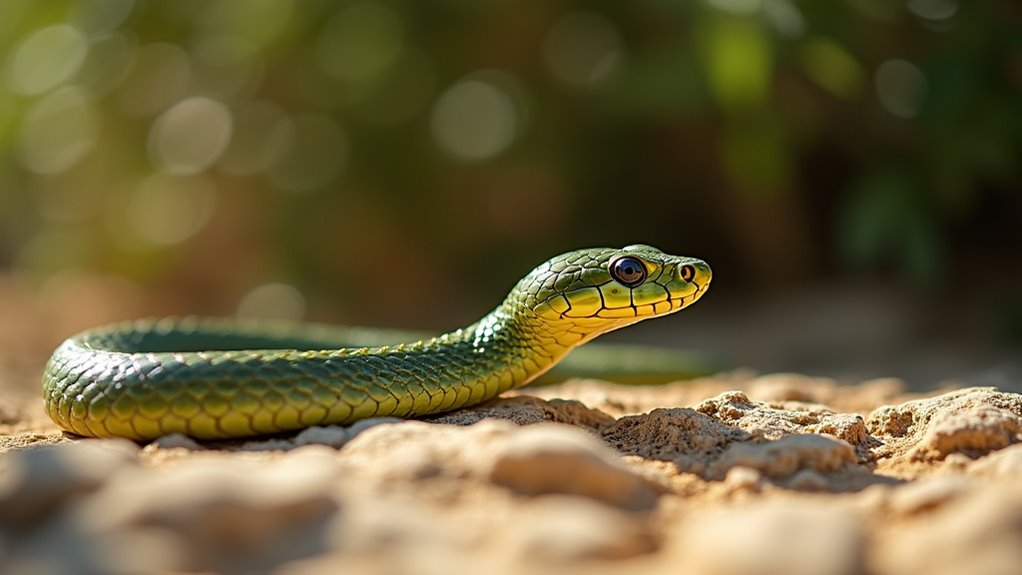
Discover Portugal's diverse snake population, from harmless garden dwellers to rare vipers that might surprise you during your travels.
Portugal hosts several snake species you’ll likely encounter while exploring. The harmless Ladder Snake controls rodent populations in scrublands, while the agile Horseshoe Whip Snake hunts in rocky areas. Near water, you’ll find the Viperine Snake mimicking dangerous species. The Montpellier Snake grows largest at 2.5m with mild venom. Rarer species include the secretive False Smooth Snake and two vipers—Lataste’s and Seoane’s—which demand careful identification during your adventures.
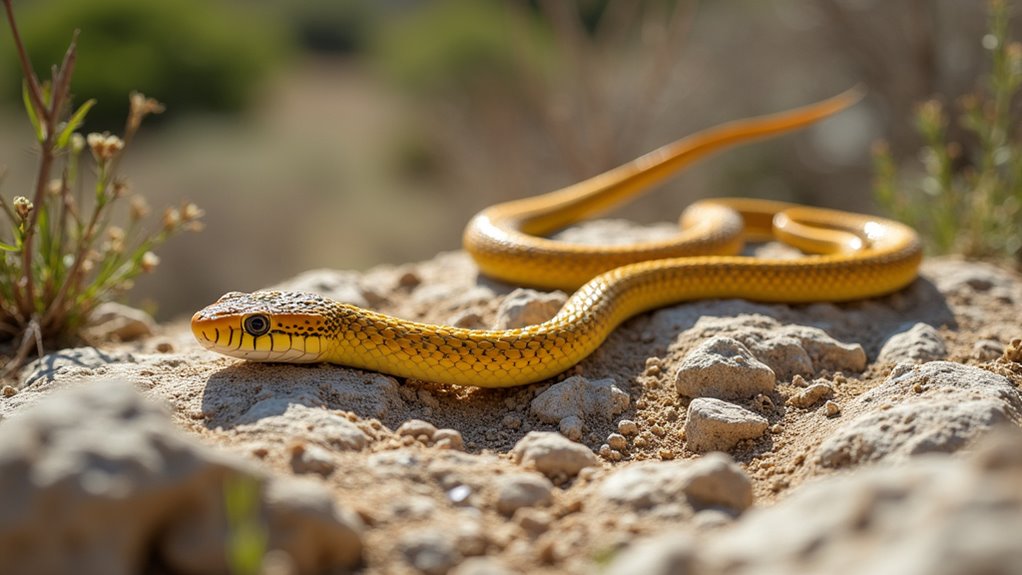
While strolling through Portugal’s sunbaked countryside, you’re likely to encounter the ladder snake (Zamenis scalaris), one of the nation’s most widespread reptiles. This non-venomous colubrid gets its name from the distinctive ladder-like pattern juveniles display, which fades to olive-brown or gray as they mature.
You’ll find these snakes throughout Portugal except in northern mountains, typically in scrublands, stone walls, and agricultural areas below 700m. They can be surprisingly defensive when threatened, exhibiting behaviors like hissing and lunging rather than fleeing immediately. They’re most active during dawn and dusk, especially in summer when they hunt primarily at night.
Don’t fear if you spot one—ladder snakes are completely harmless and actually beneficial, controlling rodent populations in rural areas. They’re perfectly adapted to Portugal’s Mediterranean climate, similar to conditions found in Greece and Malta but with their own unique ecological characteristics. They seek shelter in rocky crevices and dense vegetation when not hunting mice, birds, or lizards.
Among Portugal’s most impressive reptiles, the Horseshoe Whip Snake (Hemmorhois hippocrepis) commands attention with its remarkable speed and agility. You’ll find this slender, olive-brown snake with distinctive horseshoe-shaped markings throughout southern and central Portugal, particularly in rocky areas and shrublands. This species is recognized by its slender body and large round pupil surrounded by small scales, making identification easier for careful observers.
Growing to 1-1.5m long, this non-venomous colubrid is an excellent climber, steering stone walls and bushes with ease. Though primarily a daytime hunter, it’s adaptable enough to hunt nocturnally when necessary, preying on small mammals, birds, and lizards. While in Portugal, consider visiting clear coastal waters around Dubrovnik, Croatia for incredible marine wildlife viewing if you enjoy spotting diverse animals in their natural habitats.
If you’re exploring Portugal’s Mediterranean landscapes, watch for this snake basking on sun-exposed slopes. While it’s classified as Near Threatened in some regions due to habitat loss, you’ll still encounter it in various environments, including urban areas.
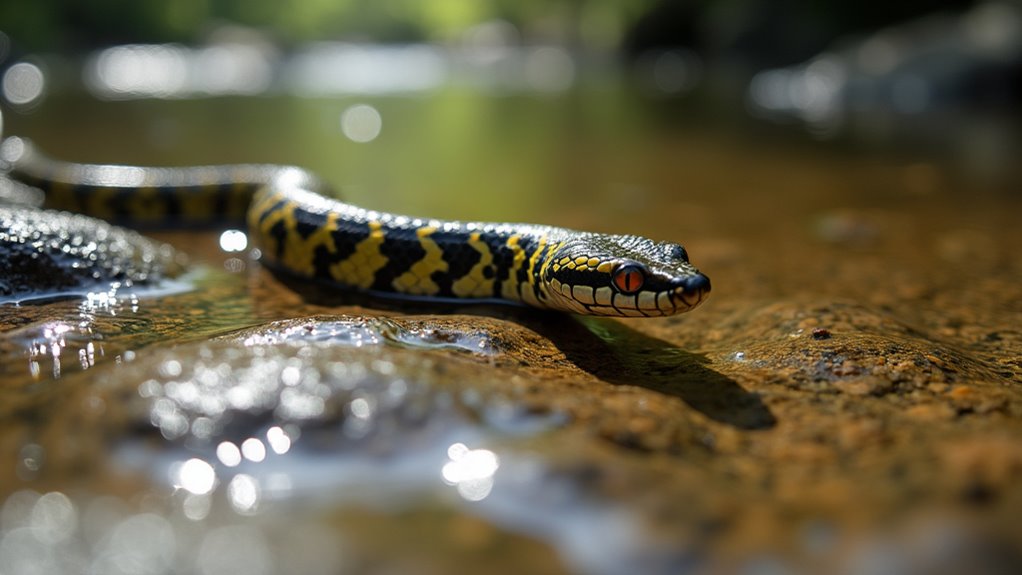
The Viperine Snake (Natrix maura) represents one of Portugal’s most fascinating aquatic reptiles, combining deceptive appearances with specialized water-dwelling behaviors. You’ll find these clever mimics throughout Portugal’s wetlands, rivers, and coastal areas, almost always within striking distance of fresh water.
Don’t be fooled by their zigzag pattern and aggressive display—they’re harmless non-venomous snakes that benefit from resembling dangerous vipers. Unlike their lookalikes, they’re round pupils and lack fangs. While exploring Portugal, you might appreciate the rich biodiversity that contributes to the country’s natural heritage, similar to its diverse food culture.
These skilled swimmers hunt fish and amphibians, either by ambushing prey or actively foraging in shallow waters. When threatened, they may flatten their heads and make striking motions to enhance their resemblance to venomous adders. Look for them basking on rocks or riverbanks during cooler daylight hours.
If you’re exploring Portuguese waterways below 1,000 meters elevation, you might spot one of these remarkable water specialists.
Impressive in both size and presence, Portugal’s largest serpent, the Montpellier Snake (Malpolon monspessulanus), commands respect across the country’s central and southern regions.
Reaching 2.55m and weighing up to 2kg, you’ll recognize it by its olive-green to grayish coloration, smooth scales, and distinctive orange-yellow eyes.
You’ll find these strictly diurnal hunters in Mediterranean climates below 2,100m, particularly in cereal fields near gallery vegetation.
They’re swift movers with semi-arboreal tendencies, often climbing shrubs to bask or hunt.
Though mildly venomous through rear fangs, they’re primarily lizard specialists that also consume small mammals and birds. This species poses low danger to humans due to both the positioning of its fangs and the mild nature of its venom.
While exploring Croatia’s party destinations at night, you’re unlikely to encounter these snakes as they are exclusively active during daylight hours.
Despite road mortality concerns, their populations remain stable, earning them IUCN Least Concern status as they adapt well to modified habitats.
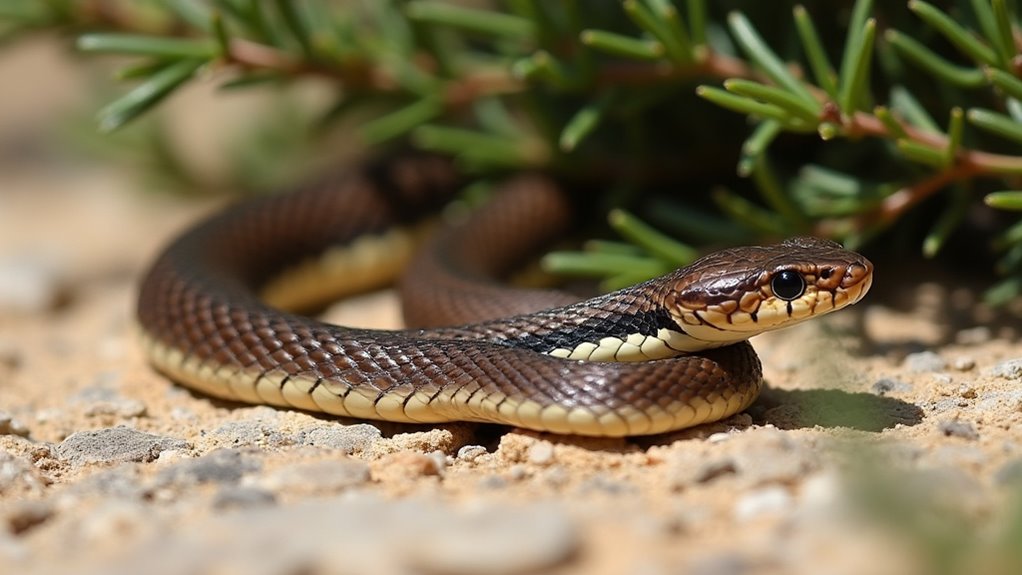
Found primarily in southern Portugal, this shy reptile spends most of its time hidden in underground galleries, stone crevices, and leaf litter.
You’re most likely to glimpse one during dawn or dusk when it emerges to hunt small lizards and geckos.
Despite possessing rear-grooved fangs and mild venom for subduing prey, these small snakes (typically 12-16 cm) pose no threat to humans.
They’ll retreat rather than confront perceived dangers.
These snakes primarily consume vertebrate reptiles and show a preference for elongated prey species that live under rocks.
Unlike Turkey, which has nine venomous species that require caution when encountered in the wild, Portugal’s snake population is generally less dangerous to humans.
These adaptable creatures inhabit diverse environments from coastal dunes to pine forests and rural gardens.
Though not globally threatened, their populations face pressure from habitat loss as agricultural expansion continues across their Mediterranean range.
As Portugal’s most medically significant venomous reptile, Lataste’s Viper demands careful identification from hikers and nature enthusiasts exploring the countryside. You’ll recognize this snake by its distinctive upward-pointing “horn” on the snout, gray-brown coloration with dark zigzag patterns, and vertical pupils.
You’re most likely to encounter these vipers in coastal regions and scrublands, particularly around Doñana’s marshes and dunes. The species is notable for having a yellow tail tip that can sometimes be visible when the snake is moving away. They’re ambush predators, most active during dawn and dusk in warm months. If you spot one, keep your distance—they’ll hiss defensively when threatened.
Their populations face significant decline due to habitat fragmentation, with projected losses exceeding 80% without conservation intervention. Unlike European brown bears that attract wildlife tourism in other parts of Europe, these vipers receive less conservation attention despite their ecological importance. As key mesopredators controlling rodent populations, their presence indicates healthy Mediterranean ecosystems, making their protection essential for Portugal’s biodiversity.
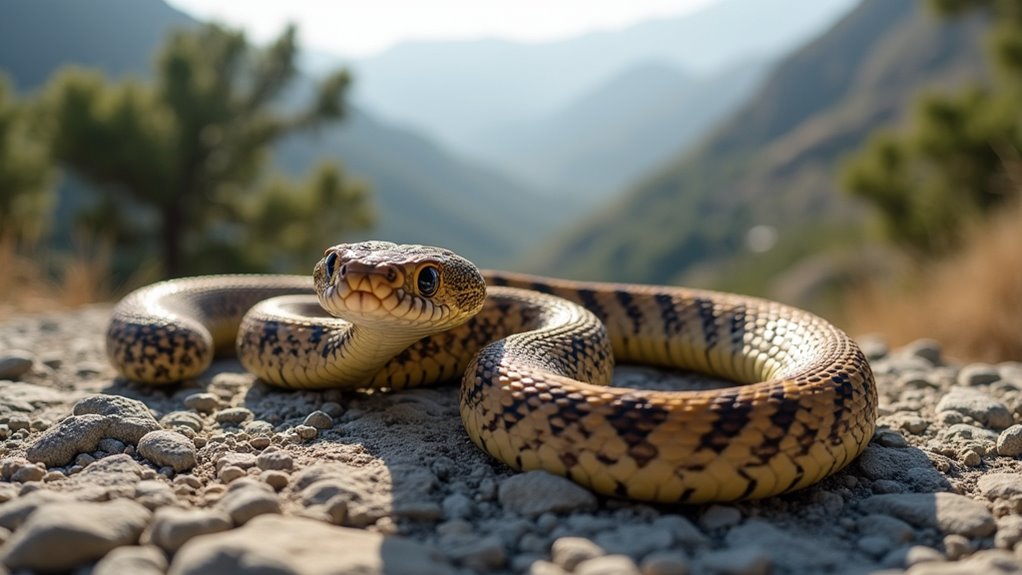
While Lataste’s Viper dominates southern regions, Seoane’s Viper reigns as Portugal’s northern mountain specialist, thriving in the country’s uppermost territories.
You’ll find this distinctive snake exclusively in Portugal’s mountainous north, where it inhabits scrubland, woodland edges, and agricultural areas with hedgerows.
These vipers display remarkable color variation—gray, brown, or reddish morphs with characteristic zigzag patterns along their backs. The species shows high polymorphism with four distinct color-pattern types ranging from zigzag patterns to twin-striped forms.
They typically reach 50-60 cm in length.
Though classified as “Least Concern” by the IUCN, they face localized population declines due to habitat loss and human persecution.
If you’re hiking northern Portuguese mountains, watch for these snakes near water sources or in humid environments. After a day of exploring, travelers might visit Stockholm’s nightlife for a complete contrast to the natural wilderness experience.
They’re vital predators of small mammals and serve as important indicators of habitat quality in their fragmented range.
Portugal’s seven common snake species make your outdoor adventures more fascinating once you know what to look for. Isn’t it remarkable how these diverse serpents have adapted to specific habitats across the country? While only the vipers pose any significant danger, all deserve your respect and distance. Armed with this knowledge, you’ll confidently identify these slithering residents during your next Portuguese countryside exploration—enhancing both your safety and appreciation of nature.